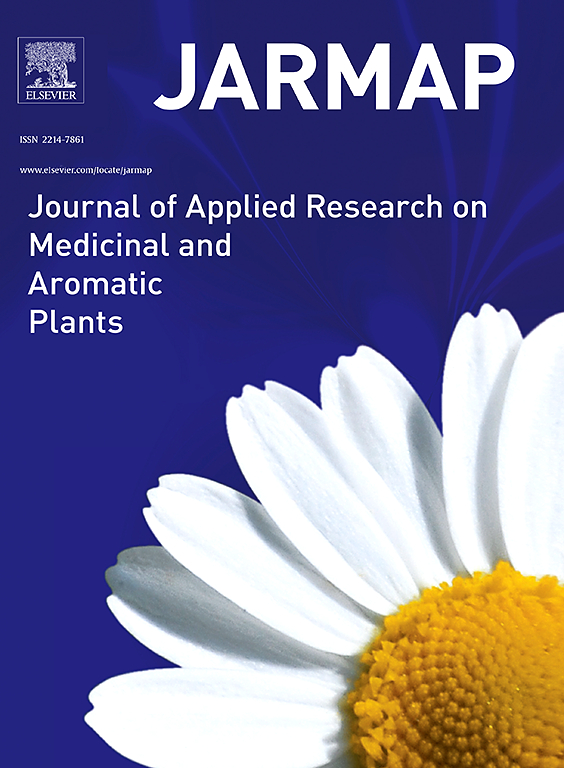Seasonal changes in chemical content of edible flowers of common daisy (Bellis perennis L.)
IF 3.6
2区 农林科学
Q1 PLANT SCIENCES
Journal of Applied Research on Medicinal and Aromatic Plants
Pub Date : 2025-09-30
DOI:10.1016/j.jarmap.2025.100667
引用次数: 0
Abstract
In the context of increasing popularity of alternative sources of food such as edible flowers the chemical composition of edible flowers of Bellis perennis L. was evaluated in this study. Common daisy, widely spread across the world, contains many bioactive compounds including ones with strong antioxidant activity, such as L-ascorbic acid or polyphenols. B. perennis flowers were sampled monthly during 2016–2023 have been analysed for chemical composition. Ascorbic acid content (AA) was monitored for eight years, and the rest of chemical assays including total phenolic content (TPC), total flavonoid content (TFC), total antioxidant capacity (TAC) was determined for 3 years. Out of 8-year monitoring of L-ascorbic acid content, significantly highest content was detected in February and March (768.5 ± 36 mg/kg FW in March 2017; 673.6 ± 18.9 mg/kg FW in Feb. 2017; 429.6 ± 1.6 mg/kg FW in Feb. 2022; 414.4 ± 11.2 mg/kg FW in Feb. 2019 and 412.2 ± 2.4 mg/kg FW in March 2018). The small mostly irregular fluctuations in TFC, TPC and TAC were determined, however for phenolic and flavonoid content the gradual increase from February till June was observed. Total antioxidant capacity in B. perennis ranged from 1.7 to 3.6 g TE/100 g DW. Despite these monthly fluctuations in bioactive compound content, the widespread availability of a common daisy throughout the year makes it a promising and accessible source of health-beneficial nutrients.
普通雏菊食用花化学成分的季节变化
在食用花等替代食物来源日益普及的背景下,本研究对多年生Bellis perennis L.食用花的化学成分进行了评价。雏菊是一种广泛分布在世界各地的植物,它含有许多生物活性化合物,其中包括l -抗坏血酸或多酚类物质,具有很强的抗氧化活性。对2016-2023年期间每月取样的多年生花进行了化学成分分析。测定抗坏血酸含量(AA)为8年,测定总酚含量(TPC)、总黄酮含量(TFC)、总抗氧化能力(TAC)为3年。8年监测L-ascorbic酸含量,显著最高内容被发现在2月和3月(768.5 ± 36 毫克/公斤弗兰克-威廉姆斯在2017年3月, 673.6±18.9 毫克/公斤弗兰克-威廉姆斯在2017年2月, 429.6±1.6 毫克/公斤弗兰克-威廉姆斯在2022年2月, 414.4±11.2 毫克/公斤弗兰克-威廉姆斯在2019年2月和412.2 ±2.4 毫克/公斤弗兰克-威廉姆斯在2018年3月)。TFC、TPC和TAC的波动较小,且多为不规则波动,但酚类和类黄酮含量在2 - 6月呈逐渐上升趋势。多年生白杨的总抗氧化能力为1.7 ~ 3.6 g TE/100 g DW。尽管生物活性化合物含量每月都有波动,但普通雏菊一年四季的广泛供应使其成为有益健康的营养物质的有希望和可获得的来源。
本文章由计算机程序翻译,如有差异,请以英文原文为准。
求助全文
约1分钟内获得全文
求助全文
来源期刊

Journal of Applied Research on Medicinal and Aromatic Plants
Pharmacology, Toxicology and Pharmaceutics-Drug Discovery
CiteScore
6.40
自引率
7.70%
发文量
80
审稿时长
41 days
期刊介绍:
JARMAP is a peer reviewed and multidisciplinary communication platform, covering all aspects of the raw material supply chain of medicinal and aromatic plants. JARMAP aims to improve production of tailor made commodities by addressing the various requirements of manufacturers of herbal medicines, herbal teas, seasoning herbs, food and feed supplements and cosmetics. JARMAP covers research on genetic resources, breeding, wild-collection, domestication, propagation, cultivation, phytopathology and plant protection, mechanization, conservation, processing, quality assurance, analytics and economics. JARMAP publishes reviews, original research articles and short communications related to research.
 求助内容:
求助内容: 应助结果提醒方式:
应助结果提醒方式:


